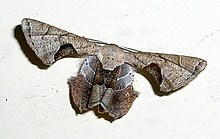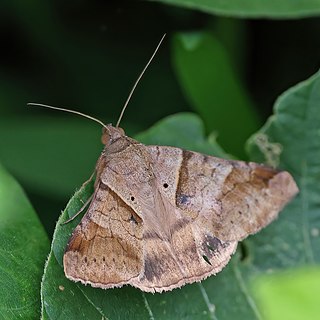
Mocis undata, the brown-striped semilooper, is a moth of the family Erebidae. The species was first described by Johan Christian Fabricius in 1775. It is found in the Afrotropical and Oriental regions, including India and Sri Lanka.

Utetheisa pulchelloides, the heliotrope moth, is a moth of the family Erebidae. It is found in the Indo-Australian region including Borneo, Hong Kong, New Zealand, Papua, Seychelles, most of Australia,Tenerife and La Línea de la Concepción [Cádiz]. The species was first described by George Hampson in 1907.

Arsacia is a monotypic moth genus of the family Noctuidae. Its only species is Arsacia rectalis. Both the genus and species were described by Francis Walker, the genus in 1866 and the species in 1863. It is found from the Indo-Australian tropics of India, Sri Lanka to Queensland and the Solomon Islands.

Yepcalphis is a monotypic moth genus of the family Noctuidae erected by Nye in 1975. Its only species, Yepcalphis dilectissima, was first described by Francis Walker in 1858. It is found in Sri Lanka, the Oriental tropics, the Philippines, Sulawesi and the Sula Islands.
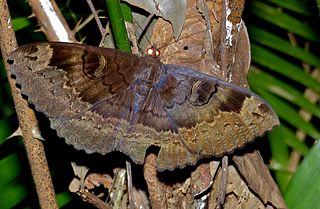
Erebus caprimulgus is a moth of the family Erebidae. It is found from the Oriental Region of India, Sri Lanka, Myanmar to Peninsular Malaysia, Sumatra and Borneo. It also occurs in Taiwan.

Ophisma gravata is a moth of the family Noctuidae first described by Achille Guenée in 1852. It is found from the Indo-Australian tropics of India, Sri Lanka, to Okinawa, Taiwan, the Caroline Islands, New Guinea, eastern Australia and New Caledonia.

Eudocima homaena is a moth of the family Erebidae first described by Jacob Hübner in 1816. It is found in the Indian subregion, Sri Lanka, Myanmar, Taiwan, the Nicobars, Peninsular Malaysia, Borneo, the Philippines and on Christmas Island. It is a major pest on orange plants.
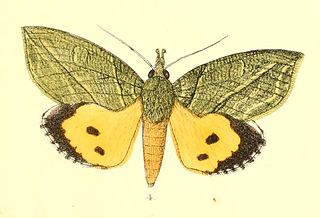
Eudocima hypermnestra is a moth of the family Erebidae described by Pieter Cramer in 1780. It is found in China, Thailand, Taiwan, India and Sri Lanka.

Eudocima salaminia, the green fruit-piercing moth, is a moth of the family Erebidae. The species was first described by Pieter Cramer in 1777. It is found from India, and across south-east Asia to the Pacific Islands. In Australia it occurs in the Northern Territory, Queensland and New South Wales. The adult is a fruit piercer.

Berta chrysolineata is a species of moth of the family Geometridae described by Francis Walker in 1863. It is widespread from the Indo-Australian tropics of India, Sri Lanka to the Solomons.

Eucyclodes gavissima, the Oriental orange banded green geometer moth, is a species of moth of the family Geometridae described by Francis Walker in 1861. It is found in the Indian subregion, Sri Lanka, Bhutan, western China, Taiwan, Vietnam, Sumatra and Borneo.
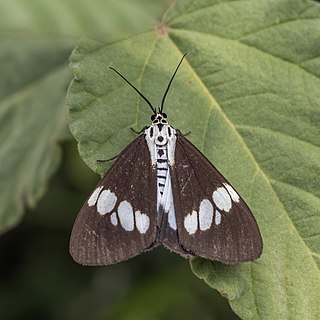
Nyctemera lacticinia, the common nyctemera, is a species of moth inf the family Erebidae. The species was first described by Augustus Radcliffe Grote in 1873. It is found in Japan, from the Oriental tropics of India, Sri Lanka, Myanmar to Taiwan, Peninsular Malaysia and Borneo.

Phazaca is a genus of moths in the family Uraniidae first described by Walker in 1863.

Gesonia obeditalis is a species of moth of the family Noctuidae first described by Francis Walker in 1859. It is found from eastern Africa, the Seychelles, the Maldives and the Oriental tropics of India, Myanmar, Sri Lanka east to the Philippines, the Sula Islands and Australia. The adult moth has brown wings with a scalloped dark brown band near the margin. The hindwings are similar in pattern to the forewings but are a paler shade of brown.

Phazaca theclata is a moth of the family Uraniidae. It was first described by Achille Guenée in 1858. It is known from Africa south of the Sahara, from Saudi Arabia, as well as from India, Japan, Myanmar, Nepal and Sri Lanka.
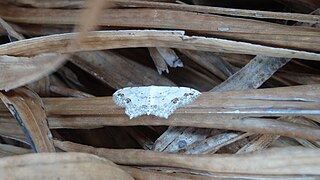
Scopula pulchellata is a moth of the family Geometridae. It is found in the Indo-Australian tropics, from India, Sri Lanka to Taiwan and the Solomon Islands, as well as in Africa.

Rhinoprora palpata is a moth in the family Geometridae. It is found in the Indian subregion, Sri Lanka and western China, as well as on Java, Borneo and Taiwan. The habitat consists of mountainous areas.
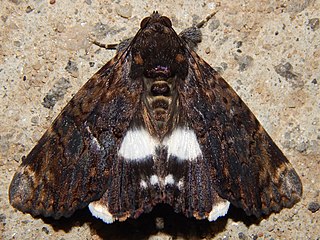
Nagia linteola is a species of moth in the family Erebidae first described by Achille Guenée in 1852. This species occurs in South Africa, the Democratic Republic of the Congo, Yemen, the Comoros, Mauritius, Madagascar, Indonesia (Borneo), India, Sri Lanka, Myanmar, Thailand and in Australia, where it has been recorded from Western Australia, the Northern Territory, Queensland and Victoria.

Hypomecis separata is a species of moth of the family Geometridae. It was first described by Francis Walker in 1863. It is found in Sri Lanka, India, Java and Borneo.

Erygia apicalis is a moth of the family Erebidae first described by Achille Guenée in 1852. It is found from the Indo-Australian tropics of India, Sri Lanka to Japan, Australia and the Solomon Islands.
